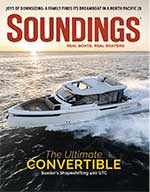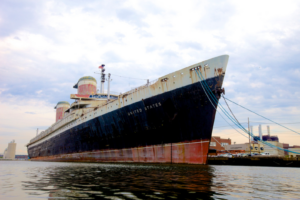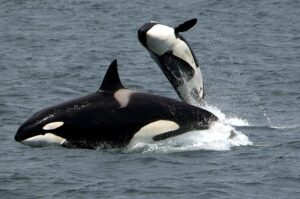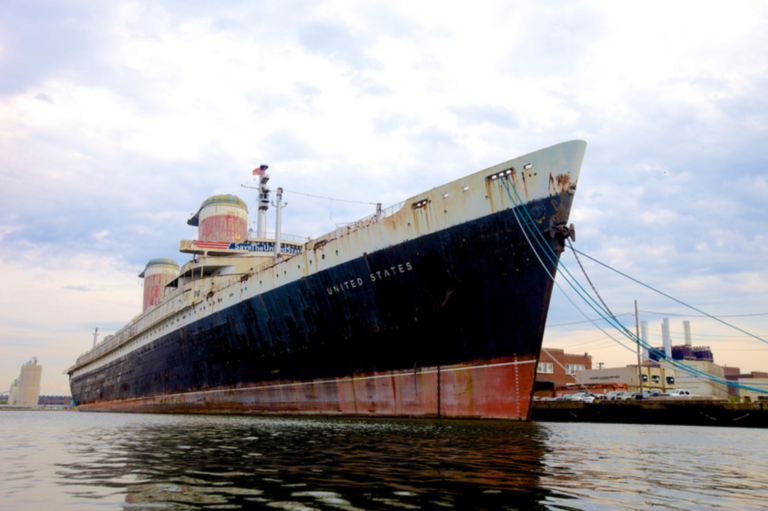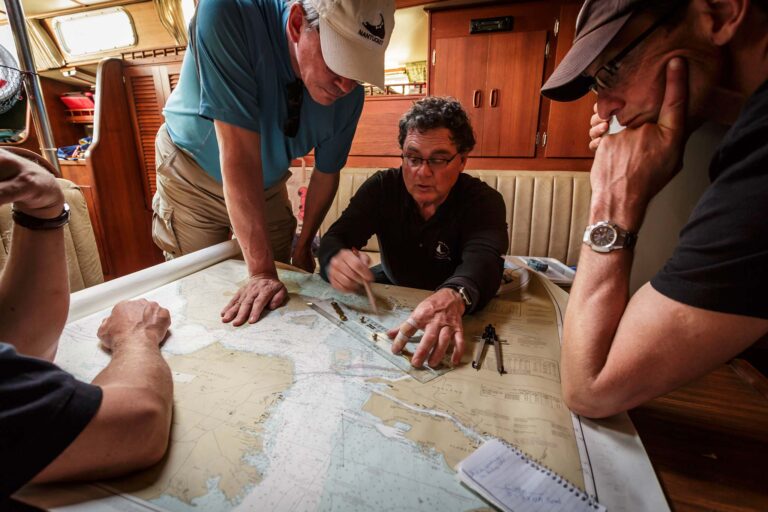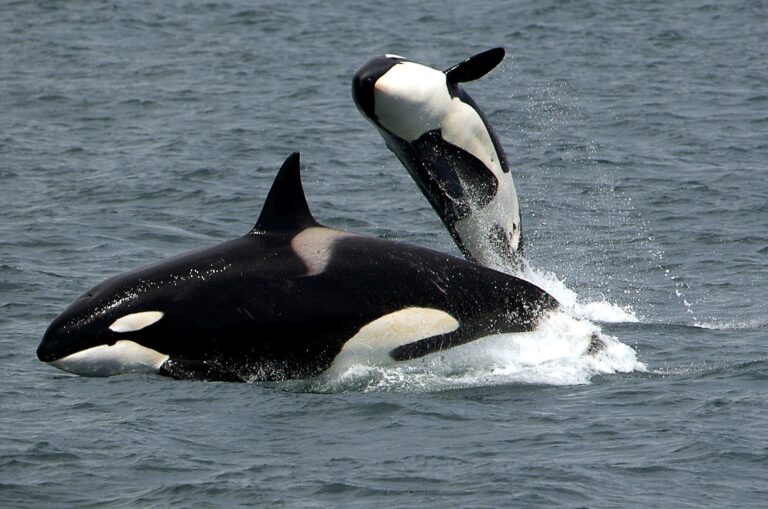As the Coast Guard looks into the skipper’s decision to ‘squeeze around’ Superstorm Sandy, one question looms large: What was he thinking?
The Coast Guard is investigating the sinking of the HMS Bounty amid hard questions about why the tall ship left New London, Conn., for St. Petersburg, Fla., as Hurricane Sandy — perhaps the largest storm ever to form in the Atlantic Basin — churned up the East Coast.
The square-rigger, built in 1960-61 for the 1962 film “Mutiny on the Bounty,” starring Marlon Brando, sank Oct. 29 about 90 miles southeast of Hatteras, N.C., in 40-mph winds and 18-foot seas. The 180-foot wooden ship (sparred length) had been taking on water and settled lower and lower, her decks awash, and eventually foundered after its generators and engines failed, silencing the pumps as water filled the bilges.

The Coast Guard rescued 13 of Bounty’s crewmembers from two life rafts and a 14th from the sea nearby. Two others died: Capt. Robin Walbridge, 63, Bounty’s master of 17 years, and crewmember Claudene Christian, 42, great-great-great-great-great granddaughter of Fletcher Christian, the mate who seized command from Capt. William Bligh in the 1789 mutiny aboard the Bounty. They reportedly were washed overboard during the transfer to the life rafts. The Coast Guard recovered Christian’s body later in the day. Walbridge remained missing after an exhaustive search. All of the crewmembers were wearing survival suits.
“We’re working with the Coast Guard and supplying them everything they need,” says Tracie Simonin, director of the HMS Bounty Organization LLC of East Setauket, N.Y., which operates the ship for owner/businessman Robert Hansen. “We trust their findings will tell us what happened.”
The crew radioed their home base at about 8:45 p.m. Sunday, Oct. 28, that the ship was taking on water, according to the Coast Guard. Simonin says she thought the water was “normal seepage in a wooden vessel,” but in an exclusive interview with ABC’s “Good Morning America” the crew says they had encountered 70-mph winds and seas three stories high earlier that day. In the pounding the Bounty took, seams may have opened some and let in more water than anyone expected. In any case, by late Sunday, water had been entering the ship at a worrisome rate for 24 hours, the crew told ABC News, and the pumps were not keeping up.
“As soon as we got the call from the ship we contacted the Coast Guard,” Simonin says.
The Coast Guard says the report from the owners, who subsequently lost radio contact with the crew, was that the ship was taking on water and had lost propulsion. Fifteen minutes after that call, at 9 p.m., the Coast Guard received an EPIRB signal from the Bounty confirming its location — and its distress. By midnight, a Coast Guard Hercules 130 was circling the struggling ship and had re-established VHF contact with the crew. The Coast Guard says the ship’s situation continued to deteriorate until 4:30 a.m. Monday, the 29th, when Walbridge ordered his crew to abandon ship in their survival suits and board the vessel’s two canopied 25-foot life rafts — no mean feat in the 18-foot seas.
As the crew transferred, a wave broadsided the ship and knocked it on its side, throwing several crewmembers into the roiling sea, the crew told “Good Morning America.” Crewman Chris Barksdale told a CBS affiliate in Charlottesville, Va., that at least five of them were washed overboard, but they found a life raft canister floating nearby and deployed it. Two hours later a helicopter was hovering over the tall ship, now awash and in its death throes. The helicopter hoisted five survivors, one directly from the water. Another Jayhawk rescued nine. All were flown to Air Station Elizabeth City, N.C.

Why put to sea?
Concerned about the implications of the Bounty sinking for other ships of its class — that is, tall ships, old ships, wooden ships — the Coast Guard says it will investigate the cause of the tragedy; whether there was any failure of material or equipment; any misconduct, inattention to duty, negligence or willful violation of the law by any of Bounty’s licensed or certificated crew; whether the Coast Guard or another agency contributed to the loss; and whether a Marine Board of Investigation ought to be convened.
That’s a lot to chew on, but the most insistent question is: Why did Walbridge go to sea with 15 crewmembers — ages 20 to 66, some experienced, some not — while a mammoth, well-forecast and closely watched hurricane bore down with a tropical force wind field spanning 940 miles and 12-foot seas ranging across 1,500 miles?
“The damned [storm] is too out of control, too big, too monstrous,” and to think you might be able to “squeeze around” it — as Walbridge at one point described his escape strategy on Bounty’s Facebook page — in a snub-nosed, square-rigged ship that slogs to windward and tops out at 8 to 10 knots “is too silly for words,” says Capt. Jan Miles, a 35-year veteran of tall ships and one of the captains on the 157-foot (sparred length) topsail schooner Pride of Baltimore. “We don’t know what he was thinking. Sadly, he’s not here to tell us.”
Other ship captains heard the forecast and stayed in port. Picton Castle, a 179-foot steel-hulled barque, remained in its home port of Lunenburg, Nova Scotia, until Sandy was no longer a threat before setting off for the South Pacific. “The Picton Castle was scheduled to depart on this current voyage on or about Oct. 22,” says Susan Corkum-Greek, from the ship’s home office. “In reviewing the forecasts and other weather data available at that time, Capt. [Dan] Moreland, in consultation with our mates, decided first to delay by a day, then two additional days and then postponed our departure indefinitely until what was clearly an incredibly large storm system was able to pass. In the end, the Picton Castle did not depart until Saturday, Nov. 3.”
On Facebook, Walbridge explained Oct. 25, as Bounty left New London, that he planned to sail east, then south to maneuver around the worst of the storm. But Sandy was just too big. By Oct. 27 he was sailing back southwest, and on the 28th he was off North Carolina’s Outer Banks, 180 miles northwest of Sandy’s eye, which still was churning north-northeast before turning toward the New Jersey shore. Then Walbridge said on Facebook that he hoped to “go fast and squeeze by” between land and Sandy’s west side.
Miles and Richard Dein, a retired Coast Guard officer and expert witness in seamanship and navigation for 35 years, both say that if Walbridge believed he had to leave New London he should have planned to depart with plenty of time to put into a safe harbor farther south — perhaps at Norfolk, Va. “There are a lot of safe places he could have gone into around Norfolk,” Dein says. “He stuck his nose out. He saw the forecast. He should have realized this was not the best thing for him to do and diverted to Norfolk.”
Simonin says she and owner Hansen had full confidence and trust in Walbridge’s judgment as Bounty departed New London. “Obviously he was the captain of the vessel, and he knew the vessel better than anyone else,” she says. “We stand by his decisions 100 percent to sail or not sail.”
‘Safer at sea’
Bounty was an uninspected passenger vessel classed as a dockside attraction — essentially a “floating museum,” as Simonin describes it, and not a sail-training vessel. It was scheduled to dock at The Pier in St. Petersburg Nov. 10-11 for dockside tours at $10 a head ($5 for children) and from there sail to Galveston, Texas, for the winter and more tours. Walbridge was under no great pressure — financial or otherwise — to make St. Petersburg by Nov. 10, Simonin says. “Yes, we had a scheduled event to appear at, but that’s not unusual,” she says. “If he can’t get someplace by a certain time, we cancel.”
Walbridge was liked and respected by his crewmembers and employers. “He was a quiet person but one of the most intelligent men I’ve ever known,” Simonin says, and one who cared about his crew. “He [treated them] like they were his own children. He was one of the most gentle and kindly men I’ve ever met. He will be truly missed. It’s a huge loss for us.”

After 17 years on the Bounty, “He knew everything about that ship from top to bottom,” Simonin says. “It was his life.”
The ship was Walbridge’s life, and that may give some insight into why he left New London. ”A ship is safer at sea than in port!” Bounty’s Facebook page said two days after the crew had left New London. Crewman Barksdale told a television reporter that Walbridge called the crew together in New London; told them he believed the ship would be safer at sea, working its way around the hurricane; and gave anyone who thought better of that the option of staying in port.
“Naturally I thought about it,” Barksdale told the TV station. “But the captain had a good plan to circumvent the storm, and at that point we didn’t realize the magnitude of the storm.” None of the crewmembers stayed in New London.
Although some ships — fast, strong ones such as Navy destroyers, supertankers and aircraft carriers — may be safer at sea, many others — slower, smaller vessels, wooden square-riggers such as the Bounty — are not, says Andy Chase, professor of meteorology, navigation and auxiliary sail at the Maine Maritime Academy in Castine. “For the rest of us [whose ships are not large], that is not a valid approach these days,” he says. “It may be the safest place if you’ve got time and maneuverability, but I’d rather have a ship in port and everyone ashore than see this happen.”
Dein agrees, as does Miles. “The whole idea of going out and jousting with a hurricane unless you’re running away from one or being overtaken by one and have no option is just plain mind- boggling,” Miles says. If you leave port, you don’t sail into a hurricane, but away from it, he argues.
In an August video interview with Belfast (Maine) Community TV, Walbridge told a reporter, “We say there’s no such thing as bad weather. There are just different kinds of weather.” He went on to explain: “We chase hurricanes. You try to get up as close to the eye of it as you can, and you stay down in the southeast quadrant. When it stops, you stop. You don’t want to get out in front of it. You want to stay behind it, but you also get a pretty good ride out of it.”

Showmanship or hubris? In light of Bounty’s sinking, “hubris,” Miles opines. “The weather prognosticators knew exactly what that storm was going to do. It was a wake-up call for all slower vessels [to invoke] the Mariner’s 1-2-3 Rule,” he says. The rule projects a danger area out ahead of a storm that encompasses the outermost radius of the projected 34-knot wind field, plus a safety margin radius of 100 miles at the 24-hour, 200 miles at the 48-hour and 300 miles at the 72-hour forecast positions for the storm to take into account forecaster error.
Miles believes adherence to the 1-2-3 Rule would have kept Bounty in port, diverted her to a safe harbor well before the 28th or sent her sailing away from the hurricane. Instead “he spent three days working his way toward Sandy,” Miles says.
An old ship made new

By some accounts, Bounty was in her best shape in years. When Hansen bought her in 2001, the ship was sinking at her dock in Fall River, Mass., her pumps working overtime to handle the many gallons an hour coming in through aging seams. Sample’s Shipyard — now Boothbay Harbor Shipyard in Maine — overhauled Bounty that year, replanking her, caulking seams, replacing virtually all of her frames, and installing new running gear, engines, drives, props and fuel tanks, a $1.5 million refit. The second phase of her restoration was completed in Bayou La Batre, La., in 2004, where most of her rigging and sails were replaced.
Back in Boothbay in April 2006, the yard replaced Bounty’s bow, stern and decking in a $2 million project. On Sept. 13 of this year, she arrived at the Boothbay yard for more work: a new cabin sole, replacement of some deck planks, new spars, some remodeling below and new plastic water tanks to replace stainless-steel tanks that were moved forward to serve as her diesel tanks. The ship was listed for sale with a U.K. brokerage, Eastern Yachts, this year, reportedly for $4.6 million.
Bounty left Boothbay Oct. 22 for New London, where she took a group of Navy personnel out for a sail on Long Island Sound. “She was in very good condition when she left Maine,” says David Wyman, the Castine naval architect who has helped oversee Bounty’s restoration. “The seams were not a problem. … In the last decade she had been totally rebuilt. At least 75 percent of her is rebuilt. She is not an old vessel.” She was an old vessel that had been made new.
Maine Maritime’s Chase agrees. “She was in the best shape she’d been in for a long, long time — maybe forever,” he says. He notes, too, that Walbridge and the Bounty probably had sailed in worse conditions than they faced in Sandy and came through OK, but in any severe storm the mariner must know that “your margin for error or an accident or a mishap is dramatically diminished. If one thing goes wrong, you use up your margin of error. I don’t know what the leak was, but whatever it was it was substantial. They had two strikes and you’re out at that point.”

Walbridge served as captain or crew aboard many well-known tall ships: the Gov. Stone, Vision Quest, Bill of Rights, Heritage of Miami, the Westwood and Corwith Cramer, Niagara and HMS Rose. He brought Bounty back from the graveyard after becoming her captain in 1995. Wyman gives him high marks for his seamanship. “I’ve known him for 25 years,” he says. “He’s probably one of the best seamen — one of the best skippers — I’ve ever known.”
But is any skipper good enough to challenge a storm such as Sandy? “If there’s anything we know about hurricanes, it is that they can — and do — do anything that they want,” Chase says.
That means you try to stay away from storms such as Sandy, Miles says. “You don’t try to negotiate it.”
See related article:
January 2013 issue

